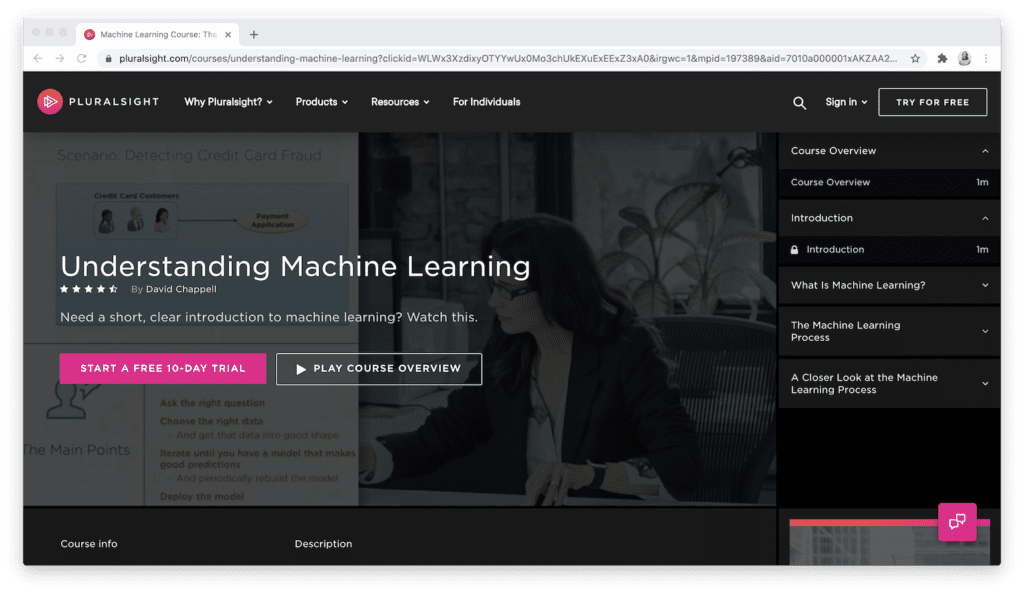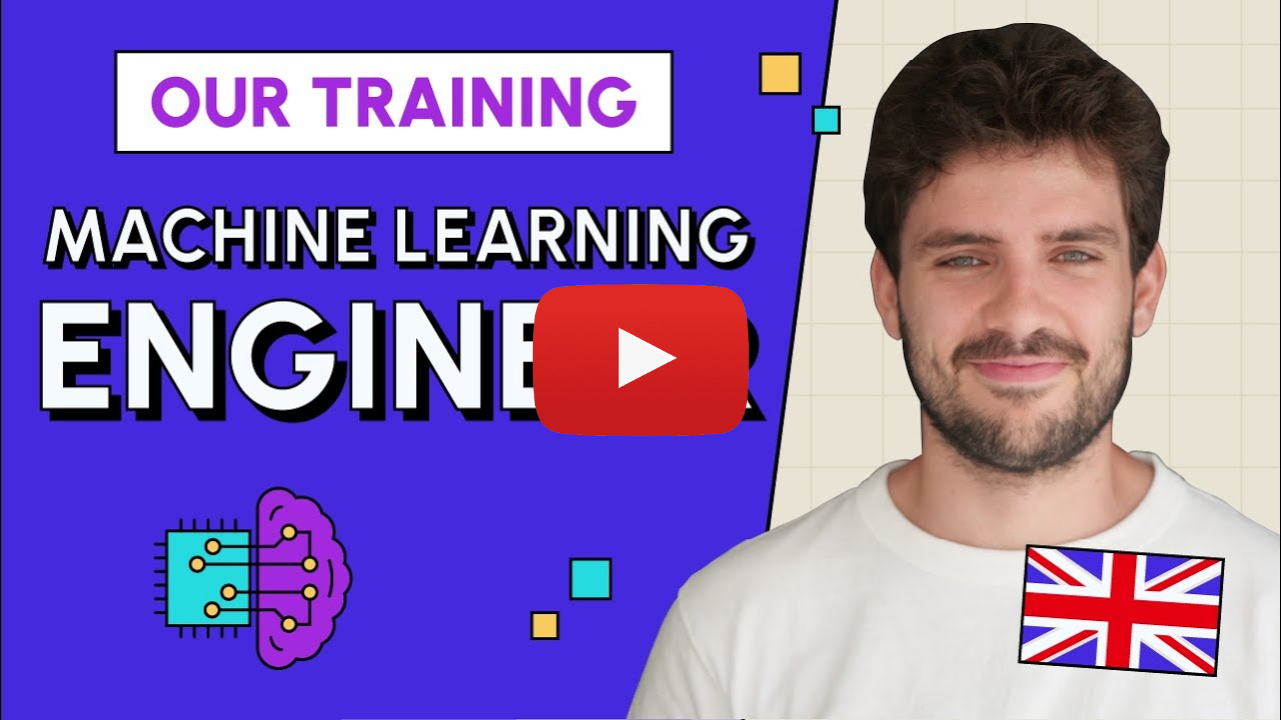All Categories
Featured
Table of Contents
- – Our Software Developer (Ai/ml) Courses - Caree...
- – Software Engineering Vs Machine Learning (Upda...
- – The 5-Second Trick For Artificial Intelligenc...
- – Machine Learning Crash Course For Beginners C...
- – The Machine Learning Engineer Course Diaries
- – Rumored Buzz on Machine Learning Crash Cours...
- – What Does How To Become A Machine Learning E...
Some people assume that that's disloyalty. Well, that's my whole occupation. If someone else did it, I'm going to utilize what that individual did. The lesson is putting that apart. I'm compeling myself to analyze the feasible remedies. It's even more regarding eating the web content and attempting to apply those ideas and much less concerning locating a collection that does the job or finding someone else that coded it.
Dig a bit deeper in the mathematics at the beginning, so I can develop that structure. Santiago: Ultimately, lesson number seven. This is a quote. It claims "You need to recognize every information of a formula if you want to use it." And after that I state, "I think this is bullshit advice." I do not believe that you have to comprehend the nuts and screws of every algorithm prior to you use it.
I would certainly have to go and inspect back to really get a far better intuition. That doesn't mean that I can not fix things making use of neural networks? It goes back to our sorting instance I believe that's just bullshit recommendations.
As a designer, I have actually worked with lots of, numerous systems and I have actually used numerous, numerous things that I do not comprehend the nuts and bolts of just how it works, also though I recognize the effect that they have. That's the last lesson on that particular thread. Alexey: The amusing point is when I believe about all these collections like Scikit-Learn the algorithms they use inside to implement, as an example, logistic regression or another thing, are not the same as the algorithms we examine in maker learning classes.
Our Software Developer (Ai/ml) Courses - Career Path Diaries
Also if we tried to discover to obtain all these fundamentals of equipment understanding, at the end, the formulas that these libraries make use of are various. Santiago: Yeah, absolutely. I assume we require a whole lot much more pragmatism in the sector.

I normally speak to those that want to work in the industry that desire to have their influence there. I do not dare to talk concerning that due to the fact that I don't understand.
Right there outside, in the market, materialism goes a long means for certain. Santiago: There you go, yeah. Alexey: It is an excellent inspirational speech.
Software Engineering Vs Machine Learning (Updated For ... - The Facts
Among things I wanted to ask you. I am taking a note to speak about progressing at coding. Initially, let's cover a couple of points. (32:50) Alexey: Let's start with core tools and structures that you require to learn to actually transition. Allow's claim I am a software program designer.
I understand Java. I understand SQL. I recognize how to make use of Git. I understand Celebration. Maybe I know Docker. All these things. And I find out about device discovering, it looks like an amazing point. What are the core tools and frameworks? Yes, I enjoyed this video and I obtain encouraged that I don't need to get deep right into math.
Santiago: Yeah, absolutely. I believe, number one, you should begin discovering a little bit of Python. Because you already recognize Java, I do not believe it's going to be a big shift for you.
Not since Python is the very same as Java, but in a week, you're gon na obtain a great deal of the distinctions there. Santiago: After that you obtain certain core devices that are going to be used throughout your whole profession.
The 5-Second Trick For Artificial Intelligence Software Development
That's a collection on Pandas for data control. And Matplotlib and Seaborn and Plotly. Those three, or one of those three, for charting and showing graphics. You get SciKit Learn for the collection of device understanding formulas. Those are devices that you're going to have to be using. I do not recommend simply going and learning more about them out of the blue.
We can speak about certain training courses later. Take among those training courses that are mosting likely to start presenting you to some problems and to some core concepts of machine understanding. Santiago: There is a program in Kaggle which is an intro. I do not keep in mind the name, but if you most likely to Kaggle, they have tutorials there completely free.
What's excellent about it is that the only need for you is to understand Python. They're going to present a trouble and tell you exactly how to use choice trees to resolve that particular problem. I think that procedure is incredibly powerful, since you go from no machine finding out background, to understanding what the trouble is and why you can not fix it with what you know right now, which is straight software application design methods.
Machine Learning Crash Course For Beginners Can Be Fun For Everyone
On the other hand, ML engineers specialize in building and releasing artificial intelligence designs. They concentrate on training versions with data to make forecasts or automate tasks. While there is overlap, AI designers deal with more diverse AI applications, while ML engineers have a narrower emphasis on machine knowing algorithms and their functional implementation.

Artificial intelligence engineers concentrate on developing and releasing device understanding designs into manufacturing systems. They work with engineering, ensuring versions are scalable, effective, and incorporated into applications. On the various other hand, information researchers have a wider duty that consists of information collection, cleansing, expedition, and building versions. They are often in charge of removing understandings and making data-driven decisions.
As companies progressively embrace AI and device knowing innovations, the need for experienced professionals expands. Artificial intelligence designers function on advanced tasks, contribute to development, and have affordable incomes. Nevertheless, success in this field calls for continual knowing and staying on par with progressing technologies and methods. Equipment learning functions are normally well-paid, with the potential for high earning capacity.
ML is basically different from traditional software application advancement as it concentrates on teaching computers to pick up from data, as opposed to programming explicit rules that are carried out methodically. Unpredictability of outcomes: You are most likely used to writing code with predictable results, whether your feature runs once or a thousand times. In ML, nonetheless, the end results are much less specific.

Pre-training and fine-tuning: How these versions are educated on large datasets and then fine-tuned for details tasks. Applications of LLMs: Such as text generation, view analysis and details search and access. Papers like "Attention is All You Required" by Vaswani et al., which presented transformers. On-line tutorials and training courses concentrating on NLP and transformers, such as the Hugging Face training course on transformers.
The Machine Learning Engineer Course Diaries
The ability to manage codebases, merge adjustments, and fix problems is equally as crucial in ML advancement as it remains in conventional software program tasks. The skills established in debugging and screening software application applications are highly transferable. While the context may transform from debugging application reasoning to identifying issues in data processing or model training the underlying principles of organized examination, theory testing, and repetitive refinement coincide.
Device discovering, at its core, is greatly reliant on data and probability theory. These are critical for comprehending exactly how formulas pick up from information, make predictions, and evaluate their performance. You should take into consideration ending up being comfy with principles like analytical relevance, circulations, theory testing, and Bayesian thinking in order to layout and analyze versions successfully.
For those thinking about LLMs, a detailed understanding of deep understanding designs is useful. This includes not only the technicians of neural networks however additionally the design of specific models for different usage situations, like CNNs (Convolutional Neural Networks) for photo processing and RNNs (Recurrent Neural Networks) and transformers for sequential data and natural language handling.
You must understand these concerns and find out techniques for identifying, reducing, and connecting concerning bias in ML versions. This consists of the potential impact of automated choices and the honest ramifications. Many versions, specifically LLMs, need substantial computational sources that are often supplied by cloud systems like AWS, Google Cloud, and Azure.
Structure these abilities will certainly not just assist in an effective change into ML but also make sure that designers can add properly and properly to the development of this dynamic area. Theory is vital, but nothing defeats hands-on experience. Beginning working with jobs that enable you to use what you have actually learned in a functional context.
Participate in competitors: Sign up with systems like Kaggle to take part in NLP competitions. Develop your projects: Beginning with easy applications, such as a chatbot or a text summarization tool, and gradually raise intricacy. The field of ML and LLMs is swiftly progressing, with brand-new innovations and innovations arising frequently. Staying upgraded with the current research and trends is vital.
Rumored Buzz on Machine Learning Crash Course For Beginners
Join areas and online forums, such as Reddit's r/MachineLearning or neighborhood Slack channels, to discuss concepts and obtain suggestions. Go to workshops, meetups, and seminars to get in touch with other professionals in the area. Add to open-source projects or compose blog site messages concerning your discovering trip and jobs. As you get experience, start searching for possibilities to include ML and LLMs into your work, or look for brand-new roles focused on these innovations.

Vectors, matrices, and their duty in ML formulas. Terms like version, dataset, functions, labels, training, reasoning, and validation. Information collection, preprocessing strategies, design training, evaluation processes, and release factors to consider.
Choice Trees and Random Woodlands: Intuitive and interpretable versions. Assistance Vector Machines: Optimum margin category. Matching problem kinds with appropriate models. Stabilizing efficiency and intricacy. Fundamental structure of neural networks: nerve cells, layers, activation features. Layered calculation and forward propagation. Feedforward Networks, Convolutional Neural Networks (CNNs), Recurrent Neural Networks (RNNs). Photo recognition, series forecast, and time-series evaluation.
Information flow, transformation, and function design techniques. Scalability concepts and performance optimization. API-driven approaches and microservices combination. Latency monitoring, scalability, and version control. Continuous Integration/Continuous Implementation (CI/CD) for ML workflows. Design monitoring, versioning, and performance tracking. Discovering and addressing changes in model performance gradually. Attending to efficiency traffic jams and resource management.
What Does How To Become A Machine Learning Engineer Mean?

You'll be presented to 3 of the most pertinent parts of the AI/ML technique; overseen learning, neural networks, and deep discovering. You'll understand the differences between conventional programs and equipment understanding by hands-on growth in monitored knowing before constructing out intricate dispersed applications with neural networks.
This program works as an overview to maker lear ... Program More.
Table of Contents
- – Our Software Developer (Ai/ml) Courses - Caree...
- – Software Engineering Vs Machine Learning (Upda...
- – The 5-Second Trick For Artificial Intelligenc...
- – Machine Learning Crash Course For Beginners C...
- – The Machine Learning Engineer Course Diaries
- – Rumored Buzz on Machine Learning Crash Cours...
- – What Does How To Become A Machine Learning E...
Latest Posts
The Ultimate Guide To Preparing For An Ios Engineering Interview
How To Prepare For Data Engineer System Design Interviews
Best Free Udemy Courses For Software Engineering Interviews
More
Latest Posts
The Ultimate Guide To Preparing For An Ios Engineering Interview
How To Prepare For Data Engineer System Design Interviews
Best Free Udemy Courses For Software Engineering Interviews